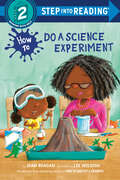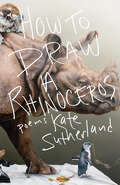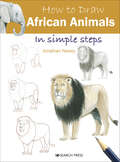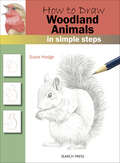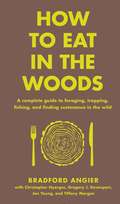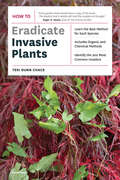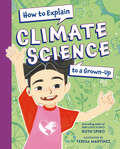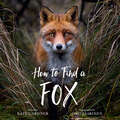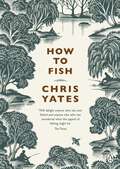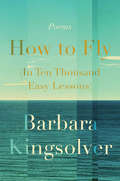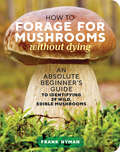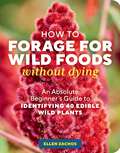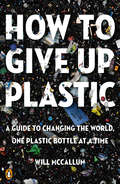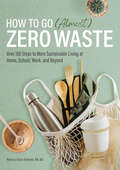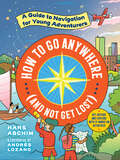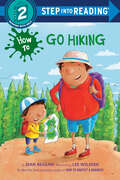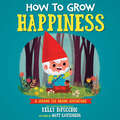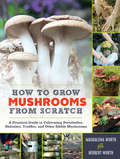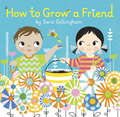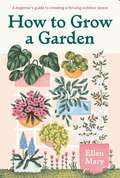- Table View
- List View
How to Do a Science Experiment (Step into Reading)
by Jean ReaganScience is a blast, when you work together with Grandma! Follow the volcano fun in this silly Step 2 early reader story from the New York Times bestselling creators of How to Babysit a Grandpa.Once you've learned how to make a volacano at home, it's time to teach Grandma what to do! But what happens when you don't remember the right ingredients? Work together with Grandma to create the best at-home volacno ever, with a few tips and tricks from the experts -- kids! This Step into Reading story features a sweet Grandma and grandchild relationship and all the silly, sticky moments that come with creating an at-home experiment. Perfect for children who are ready to read on their own! Step 2 readers use basic vocabulary and short sentences to tell simple stories. They are perfect for children who recognize familiar words and can sound out new words with help.
How to Draw a Rhinoceros
by Kate SutherlandHow to Draw a Rhinoceros, the first book of poems by Canadian writer, scholar, and lawyer Kate Sutherland, mines centuries of rhinoceros representations in art and literature to document the history of European and North American encounters with the animal--from the elephant-rhinoceros battles staged by monarchs in the Middle Ages; the rhinomania that took hold in response to the European travels of Clara the 'Dutch' Rhinoceros in the mid-1700s; the menageries and circuses of the Victorian era; the exploits of celebrated twentieth-century hunters like Teddy Roosevelt and Ernest Hemingway; and the trade in rhinoceros horn artefacts that thrives online today. Along the way, it explores themes of colonialism, animal welfare, and conservation, combining Robert Kroetschian documentary poetics with the meticulous research and environmental passion of Elizabeth Kolbert, to successfully examine the centuries-long path of the rhinoceros that's brought it to the brink of global extinction.Readers of contemporary poetry, as well as those interested in natural history, animal welfare, and conservation, and people who have followed Sutherland's scholarly and literary careers, will relish the rich detail and odd tales of historical rhinoceroses and the people who have kept, shown, and traded in them, as depicted using a range of poetic techniques that only a critical eye like Sutherland's could deliver.
How to Draw: African Animals
by Jonathan NeweyCapture the splendour of the African savannah by drawing this collection of stunning animals and birds. Watch them come to life in six easy steps. Award-winning artist Jonathan Newey teaches you to transform simple shapes into the iconic Big Five (lion, leopard, rhinoceros, elephant and buffalo), as well as towering giraffes, distinctive zebras and striking flamingos. There are 26 different animals to create, in a variety of poses and styles. Each project starts with a few basic outlines and progresses into a finished tonal drawing, and a final coloured version shows you how to develop your drawing even further. Perfect for beginners, as well as budding artists, you’ll be amazed how easily you too can draw African animals with this inspiring guide.
How to Draw: Woodland Animals
by Susie HodgeLearn how to draw all kinds of woodland animals using this fun and easy step-by-step method. Starting with simple shapes, Susie Hodge shows you how easy it is to develop circles, rectangles, squares and ovals into an exciting selection of animals and birds including rabbits, badgers, woodpeckers, wolves, squirrels and chipmunks. If you have never drawn before this is definitely the book for you, and there is a lot here to inspire more experienced artists too.
How to Eat in the Woods: A Complete Guide to Foraging, Trapping, Fishing, and Finding Sustenance in the Wild (In the Woods)
by Jon Young Bradford AngierA comprehensive, practical, and reliable guide to finding food in the woods and living off the land, by respected wilderness survivalists. With text by wilderness survivalists, the information in How to Eat in the Woods is tried, trusted, and true. One of the most complete books written on the subject, this portable guide includes essential information on how to track, trap, kill, and prepare various types of animals; select bait, land fish, and clean and cook the catch; recognize edible plants, fruits, berries, and nuts; locate bird eggs; catch edible insects; and find potable water. Also included is information on building a fire and preparing food without utensils.
How to Eradicate Invasive Plants
by Teri Dunn Chace“Every garden shed should have a copy of this book. The wisdom that it wields will hold the invaders at the gate.” —Roger B. Swain, The Victory GardenHow to Eradicate Invasive Plants offers a clear, practical solution to the increasingly common problem of invasive plants. Clearly written and easy-to-use, Teri Dunn Chance shows you how to recognize more than 200 common invasive plants and offers organic and responsible chemical eradication options for each species. With this reference on their shelves, gardeners, landscapers, and managers of public and private land across the country can confidently tackle the invasive plants to make room for a sustainable plant community!
How to Explain Climate Science to a Grown-Up (How to Explain Science to a Grown-Up)
by Ruth SpiroThe best-selling author of the Baby Loves Science series levels up with this playful STEM picture book introducing kids (and grown-ups) to climate science.Do you want to know a secret? Sometimes grown-ups need YOU to explain things to THEM. Like climate science!In this tongue-in-cheek guide, an in-the-know narrator instructs kid readers in the fine art of explaining climate science to a grown-up. Both children and their adults learn: The difference between weather and climate.How climate scientists collect data.What causes climate change.What we can do to reverse course and repair the planet.Fun and fact-filled, the How to Explain Science to a Grown-Up series will empower kid experts to explore complex scientific concepts with any grown-up who will listen.
How to Find a Fox
by Kate Gardner**Winner of the Mockingbird Award**Look for tracks. Listen for yips. Be as still as a pebble. Taking kids on an imaginary trek through different landscapes and seasons, How to Find a Fox celebrates one of our planet's most graceful and enchanting creatures: the red fox. Ossi Saarinen's stunning wildlife photos and Kate Gardner's lively and informative words capture the magical and profound connection between animals and humans. Readers will be inspired to get outside and make their own discoveries--maybe with a camera in-hand, just like Ossi.
How to Fish
by Christopher YatesSitting on a riverbank, with rod and line, must count as one of the most relaxing and enjoyable – yet occasionally frustrating – experiences known to man.Chris Yates discovered the joys of fishing early in life and was quickly hooked by its pleasures. Many years later, he is still content to sit, day after day, observing the quirks of different fish and losing track of time. For him, fishing is much more than just a question of technique; sometimes it’s about listening to nothing but your instincts, and at other times it’s about enjoying the perfect cup of tea. And it’s always about not knowing how the day is going to unfold . . .There’s no better guide for the uninitiated – and no better companion for those already familiar with the satisfactions of fishing – than Chris Yates. And immersing yourself in How To Fish is almost as delightful an activity as fishing itself.
How to Fly (In Ten Thousand Easy Lessons): Poetry
by Barbara KingsolverIn this intimate collection, the beloved author of The Poisonwood Bible and more than a dozen other New York Times bestsellers, winner or finalist for the Pulitzer and countless other prizes, now trains her eye on the everyday and the metaphysical in poems that are smartly crafted, emotionally rich, and luminous. In her second poetry collection, Barbara Kingsolver offers reflections on the practical, the spiritual, and the wild. She begins with “how to” poems addressing everyday matters such as being hopeful, married, divorced; shearing a sheep; praying to unreliable gods; doing nothing at all; and of course, flying. Next come rafts of poems about making peace (or not) with the complicated bonds of friendship and family, and making peace (or not) with death, in the many ways it finds us. Some poems reflect on the redemptive powers of art and poetry itself; others consider where everything begins.Closing the book are poems that celebrate natural wonders—birdsong and ghost-flowers, ruthless ants, clever shellfish, coral reefs, deadly deserts, and thousand-year-old beech trees—all speaking to the daring project of belonging to an untamed world beyond ourselves.Altogether, these are poems about transcendence: finding breath and lightness in life and the everyday acts of living. It’s all terribly easy and, as the title suggests, not entirely possible. Or at least, it is never quite finished.
How to Forage for Mushrooms without Dying: An Absolute Beginner's Guide to Identifying 29 Wild, Edible Mushrooms
by Frank HymanWith the surging interest in foraging for mushrooms, those new to the art need a reliable guide to distinguishing the safe fungi from the toxic. But for beginner foragers who just want to answer the question &“Can I eat it?&”, most of the books on the subject are dry, dense, and written by mycologists for other mycologists. Frank Hyman to the rescue! How to Forage for Mushrooms without Dying is the book for anyone who walks in the woods and would like to learn how to identify just the 29 edible mushrooms they&’re likely to come across. In it, Hyman offers his expert mushroom foraging advice, distilling down the most important information for the reader in colorful, folksy language that&’s easy to remember when in the field. Want an easy way to determine if a mushroom is a delicious morel or a toxic false morel? Slice it in half – &“if it&’s hollow, you can swallow,&” Hyman says. With Frank Hyman&’s expert advice and easy-to-follow guidelines, readers will be confident in identifying which mushrooms they can safely eat and which ones they should definitely avoid.
How to Forage for Wild Foods without Dying: An Absolute Beginner's Guide to Identifying 40 Edible Wild Plants
by Ellen ZachosThis on-the-go guide is perfect for new foragers eager to learn about the edible plants they're most likely to find, no matter what region they're in, and provides photos and easy-to-follow identification and use guidelines for the 40 most common—and most delicious—wild plants.How to Forage for Wild Foods without Dying is a book for anyone who likes to go on nature walks and would like to learn about the edible plants they&’re most likely to come across—no matter what region they&’re in. Author Ellen Zachos shares her considerable expertise, acquired over decades of foraging in every part of North America. She offers clear, concise descriptions of edible wild plants, in addition to any potential lookalikes, as well as critical information about proper harvesting, processing, and cooking. Zachos has curated the plant selection to include only the 40 most common, most delicious edible plants, ranging from black walnuts and juniper berries to elderflowers, burdock, fiddlehead ferns, lambsquarter, wild garlic, sunchokes, and many more. With Zachos&’s expert advice and easy-to-follow guidelines, readers will be confident in identifying which plants they can safely eat and which ones they should definitely avoid. Easy instructions for preparation and eating for maximum enjoyment are included.
How to Get Lost and Found in New Zealand (4th edition)
by John W. Mcdermott Bobbye Lee Hughes McdermottPersonally written and packed with vital information to help you go beyond the ordinary and discover the best in food, attractions, buys and more. This fourth edition encompasses fresh material and updated information as the result of their research.
How to Give Up Plastic: A Guide to Changing the World, One Plastic Bottle at a Time
by Will McCallumAn accessible guide to the changes we can all make—small and large—to rid our lives of disposable plastic and clean up the world’s oceans How to Give Up Plastic is a straightforward guide to eliminating plastic from your life. Going room by room through your home and workplace, Greenpeace activist Will McCallum teaches you how to spot disposable plastic items and find plastic-free, sustainable alternatives to each one. From carrying a reusable straw, to catching microfibers when you wash your clothes, to throwing plastic-free parties, you’ll learn new and intuitive ways to reduce plastic waste. And by arming you with a wealth of facts about global plastic consumption and anecdotes from activists fighting plastic around the world, you’ll also learn how to advocate to businesses and leaders in your community and across the country to commit to eliminating disposable plastics for good.It takes 450 years for a plastic bottle to fully biodegrade, and there are around 12.7 million tons of plastic entering the ocean each year. At our current pace, in the year 2050 there could be more plastic in the oceans than fish, by weight. These are alarming figures, but plastic pollution is an environmental crisis with a solution we can all contribute to.
How to Go (Almost) Zero Waste: Over 150 Steps to More Sustainable Living at Home, School, Work, and Beyond
by Rebecca Grace Andrews MA, MSYour easy, practical resource on the journey to sustainable living A zero-waste lifestyle can have a profound impact on our environment and the health of your home, and How to Go (Almost) Zero Waste is here to make sustainable living easier, with more than 150 different ways you can make more sustainable choices at home, school, work, and beyond. Learn how to reduce your footprint at your own pace with simple steps like carrying reusable shopping bags, more intermediate steps like mending your own clothes, and major steps like creating a garden-to-cafeteria program at your local schools. How to Go (Almost) Zero Waste offers: Changes big and small—Discover how sustainable living can be a progressive process—one manageable step at a time— that leaves you feeling successful, positive, and eager to do more. Your choice—Decide how you want to use this book, whether it's trying out steps here and there, flipping to sections of interest, or reading the whole thing before you get started—it's up to you. Progress, not perfection—This book will help you take the steps to sustainable living that you are able and comfortable with, based on your budget and lifestyle. Begin the path to more sustainable living with a book that makes it easy and manageable for anyone.
How to Go Anywhere (and Not Get Lost): A Guide to Navigation for Young Adventurers
by Hans AschimBorn to explore Get outside with this interactive book that shows how explorers have found their way around the planet for thousands of years. Read about the ancient Polynesians who tracked the stars and waves to sail precise paths through the ocean. Or the Age of European Exploration navigators who use compasses and dead reckoning to reach the New World. And learn the science behind radar and modern-day GPS satellites. Then discover how to do it yourself! With illustrated activities as well as handy tips throughout, you&’ll learn the fascinating history and seriously useful skills to become a true navigator. Up your adventure game and learn to: —Find north and south by reading the trees —Make a simple compass —Use the stars to tell time —Build a basic sextant —Get your bearings using the sun —Go treasure hunting with GPS
How to Go Hiking (Step into Reading)
by Jean ReaganLet's take a hike! Enjoy the view in this Step 2 early reader from the New York Times-bestselling creators of How to Babysit a Grandpa.New hiking boots call for a hiking adventure! Pack your backpack with snacks, water, and a map, and join an uncle and his nephew as they head out for their trip, but this time, the kids lead the way! This Step Into Reading story embraces the highs and lows of a hike in the woods--from spying lizards, to getting a blister--and of coming home again.Step 2 readers use basic vocabulary and short sentences to tell simple stories. They are perfect for children who recognize familiar words and can sound out new words with help.
How to Grow Bulbs
by Sunset Publishing StaffLearn how to grow bulbs! This book teaches beginners about identifying and gardening bulbs. Also provided is botanical information and notes on the backgrounds of common bulbs.
How to Grow Happiness
by Kelly DiPucchioJerome the Gnome takes young readers on whimsical adventures through his garden, celebrating discovery and sowing the imagination as he introduces topics such as science, environmental awareness, and agriculture.In How to Grow Happiness, Jerome and his fellow Garden of Wonder dwellers—including Oakie, his pet acorn; Nutilda, a hyperactive squirrel; and Warble, a fast-talking bird—learn what it takes to make a happiness seed blossom. Through patience, asking for help, and teamwork, Jerome and his friends take a little black seed left on a windowsill and find ways to help it grow. They soon find that as it flourishes, their own happiness does too.Jerome the Gnome teaches young readers and listeners how a garden grows, as well as how a community comes together to make the experience more rewarding—and fun!
How to Grow Herbs in the Midwest (3rd Edition)
by Ann CaseA small guide to growing some of the more common herbs in the tricky climate of mixed zone 5 & 6.
How to Grow Mushrooms from Scratch: A Practical Guide to Cultivating Portobellos, Shiitakes, Truffles, and Other Edible Mushrooms
by Magdalena Wurth Herbert WurthThis guide to growing edible mushrooms covers 19 varieties, from button mushrooms to immune-boosting reishis—plus recipes and preserving methods.Mushrooms are a joy to grow—for food, as a garden feature, or just for fun—and it’s easier than you think! Mushrooms will thrive in your garden, on your windowsill, and even in your basement. The key is to pick the right growing medium for your mushroom—a log, a bale of hay, or a simple pot of dirt—and give it a little shade.Experts Magdalena and Herbert Wurth explain every step of cultivation—whether starting from a kit, a culture, or a grown mushroom you’d like to propagate. From protecting mushrooms in extreme weather to troubleshooting pests, here is expert advice for beginners and experienced growers alike!
How to Grow Orchids
by Jack KramerHow to Grow Orchids presents the variety in the orchid family and discusses proper care and technique for cultivating orchids both inside and out.
How to Grow a Friend
by Sara GillinghamA lovely metaphor teaches valuable lessons in how to treat others and make friendships blossom! Making a friend takes patience, care, and room to bloom--just like growing a flower. Soon your little gardeners will have their very own green thumbs for this most important of life skills.
How to Grow a Garden: A beginner's guide to creating a thriving outdoor space
by Ellen MaryLearn to transform your outdoor space into a flourishing, vibrant garden with this fail-safe guide.Gardening expert Ellen Mary takes you through every step of gardening, from the basics of understanding your space and decoding plant labels, to common pests and how to keep your plants alive once they're in the ground. Packed full of practical information, this book is relevant for any beginner gardener, no matter what type of outdoor space you have - whether you're looking for ideas for green-filled balconies, or larger low-maintenance plots. You'll also find tailored advice for different levels of time investment, whether you have just 10 minutes or 4 hours per week to spend in your garden.Once you've got the basics covered, you'll learn key gardening skills including:- Planting flower beds- How and when to prune- Composting correctly- How to grow a lawn, trees and rosesSo, flex those green fingers, get your hands dirty and enjoy the process of creating a beautiful, blooming garden.
How to Grow a Garden: A beginner's guide to creating a thriving outdoor space
by Ellen MaryLearn to transform your outdoor space into a flourishing, vibrant garden with this fail-safe guide.Gardening expert Ellen Mary takes you through every step of gardening, from the basics of understanding your space and decoding plant labels, to common pests and how to keep your plants alive once they're in the ground. Packed full of practical information, this book is relevant for any beginner gardener, no matter what type of outdoor space you have - whether you're looking for ideas for green-filled balconies, or larger low-maintenance plots. You'll also find tailored advice for different levels of time investment, whether you have just 10 minutes or 4 hours per week to spend in your garden.Once you've got the basics covered, you'll learn key gardening skills including:- Planting flower beds- How and when to prune- Composting correctly- How to grow a lawn, trees and rosesSo, flex those green fingers, get your hands dirty and enjoy the process of creating a beautiful, blooming garden.
